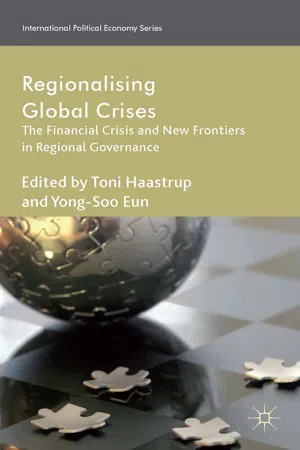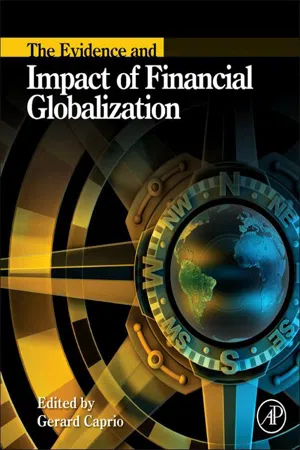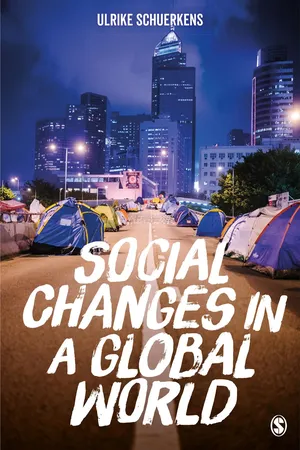Global Financial Crises
Global financial crises refer to periods of severe economic turmoil that impact multiple countries and regions around the world. These crises are characterized by widespread banking and currency failures, stock market crashes, and a sharp decline in economic activity. They often result in significant social and political consequences, and can have long-lasting effects on global economic systems and development.
4 Key excerpts on "Global Financial Crises"
- eBook - ePub
Regionalizing Global Crises
The Financial Crisis and New Frontiers in Regional Governance
- T. Haastrup, Y. Eun(Authors)
- 2014(Publication Date)
- Palgrave Macmillan(Publisher)
...This turning point often requires some sort of intervention to either maintain the status quo or to manage change. In accepting the recent global economic depression, a broad understanding of crisis is applicable because this one crisis has either triggered or exacerbated other political and social crises. One might even go so far as to suggest that other smaller crises triggered the ‘global’ financial crisis even if they had not been previously acknowledged as opportunities for change. Importantly, this particular crisis unsettles established hierarchies that constitute the international order and, consequently, the governance of the international political economy. What we find interesting is that the recent economic and financial crisis has had different implications for various self-defined regions. Yet, this condition has often been masked by the rhetorical emphasis on its ‘global’ or European nature. While this economic downturn dominates the consciousness of the global collective, in observing divergences, which consequently affect the global (inter-regional) interactions that characterize our epoch, new approaches like ‘new regionalism’ require us to contest the ‘global’ framing of international crisis in favour of evaluating regional overlays that constitute multiple crises. At best, it asks us to allow for the possibility of multiple ‘global’ narratives of the crisis and its creation of region dependent crises. While the recent discourse that accepts ongoing crises within a single global narrative is problematic, we do not suggest that the global consideration of crisis is wrong or even entirely inaccurate. Instead, the approach suggested by the empirically informed ‘new regionalism’ challenges the ‘rationalist bias of neo-liberal institutionalism’ (Acharya and Johnston, 2007, pp. 9–10), which dominates most global approaches to the international political economy...
- (Author)
- 2012(Publication Date)
- Academic Press(Publisher)
...The first global financial crisis of the twenty-first century, however, has questioned many of the old paradigms and posed new challenges for researchers. Global imbalances are of ongoing concerns, with some countries continuously running high current account surpluses or deficits. These imbalances have also led to a shift in the geography of capital flows and the socioeconomic power structure toward emerging markets. Cross-border banking with national regulators leads to new regulatory challenges, a topic which is of immediate and great concern within the European Union. The literature on currency unions will receive a new boost with the on-going problems within the Eurozone. Moreover, the overall model of financial globalization, dominant for the past 30 years, is being increasingly questioned in terms of its impact on volatility and thus its costs. Calls for a new global financial architecture are being heard! While the existing literature can speak to many of these questions and debates based on previous experiences and theoretical insights, further explorations and contributions can be expected. This is a very active field. Acknowledgment The authors are highly indebted to Lucas Nuñez for excellent research assistance and great help in assembling this overview and they thank him dearly. References 1. Bhagwati J. The capital myth: the difference between trade in widgets and dollars. Foreign Affairs. 1998;77(3):7–12. 2. Fischer S. Capital account liberalization and the role of the IMF. Essays in International Finance. 1998;207(May):1–10. 3. Fleming J. Domestic financial policies under fixed and under floating exchange rates. IMF Staff Papers. 1962;9(3):369–379. 4. Mundell R. International Economics. New York: The MacMillan Company; 1968. 5. Stiglitz J. Globalization and Discontent. New York: W. W. Norton; 2002. 6. Summers L. International financial crises: causes, prevention, and cures. American Economic Review. 2000;90(2):1–16....
- eBook - ePub
- Ulrike Schuerkens(Author)
- 2017(Publication Date)
- SAGE Publications Ltd(Publisher)
...On the other side, conflicts reveal structural contradictions of the whole system (e.g. the 1989 system break in Eastern Europe), which can only be resolved by a structural change of the system or, as Touraine emphasized, by a ‘revolution.’ A crisis lets ideas and social beliefs on given topics with their weak and strong sides appear. Today, global crises are thus periodic phenomena based no longer on only endogenous factors but on global forces and structures (see Gross, 2007; Schuerkens, 2009). The Global Communication Network and the Financial Crisis The problem with the recent financial crisis was that the global communication network was no longer controlled by responsible people, but by an irrational belief in numbers. Journalists gave the mass media ceaseless comments, so that the activities and reactions of bankers on the stock markets were published as news around the clock. The future after the crisis was and is still uncertain, and the reactions of the employees of the financial sector are still difficult to predict, such as in the recent (spring 2016) financial situation in China that has shown high debt levels of local authorities and a devaluation of the Chinese currency, or the financial crisis in emerging markets in early 2014. In order to find a solution, politics and media have realized that they cannot remain passive when bankers act irrationally. The basic rules of the complex neoliberal socio-economic system must therefore be understood, so that a global crash with an uncertain economic future can be prevented. Some Empirical Evidence of the Recent Financial Crisis in Various Regions of the World First of all, the recent global crisis was not only a financial, but also a structural crisis. This process meant the end of a model: that of the powerful and insatiable consumer, that of the saver who is confident in the financial system, and that of the producer who believes resources are inexhaustible...
- eBook - ePub
- Anthony J. Makin(Author)
- 2016(Publication Date)
- Routledge(Publisher)
...We first consider the impact of financial crises transmitted via short-term capital flow reversals, and then the role of multinational corporations as conduits of more stable long-term capital flows. The nature of financial crises Commercial banks, as intermediaries between savers and investors, have always been central to the global financial system. Financial crises occur after banks have imprudently extended too much credit to private and public sector bodies to finance unproductive economic activity with insufficient attention paid to borrowers’ creditworthiness. Typically, bank credit is advanced against temporarily inflated asset values and borrowers’ credit risk is overlooked. FIGURE 13.1 International capital flows by type Poor prudential supervision of financial institutions, lack of transparency about banks’ government–business relations, exposure to nonperforming loans and unhedged external debt all contribute to financial crises. Crises triggered by the failure of one or more banks routinely follow a boom in asset prices and then a bust. In sum, the key facets of banking and financial crises are the underestimation of default risk, followed by a sudden loss of investor confidence. What transforms a correction of asset prices into a collapse is the reinforcing panic behaviour of investors selling off financial assets and liquidating bank deposits. Contagion effects lead to large scale asset liquidation and runs on vulnerable banks, giving rise to full-blown financial crises. The causes of financial crises The Global Financial Crisis (GFC) of 2008–10 began as a banking crisis on Wall Street that devastated asset values and reverberated through financial markets and institutions around the world...



